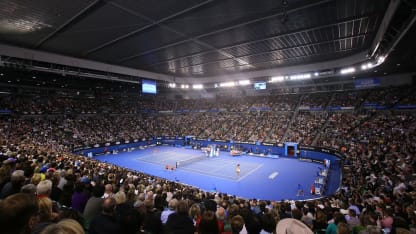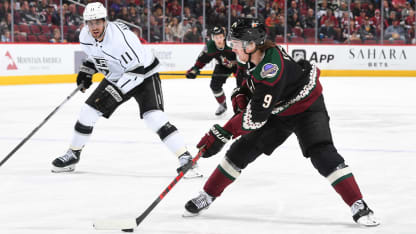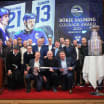The NHL is receiving strong support from Left Field Live and TEG Sports, the event promoters, and Visit Victoria, the state's tourism arm.
"We think that we're poised in Australia to really grow the game and grow the brand, despite the fact that there are very few ice hockey rinks or players in that market, because they over-index in terms of their interest in all of our platforms," White said.
Proper said the NHL believes it will be a transformative experience for people in Melbourne to see the best hockey players in the world live.
"The truth of the matter is, if it weren't so far away, it's a complete layup," Proper said. "Nobody would be questioning why you'd go there. But it's the logistics hurdle that makes everybody question it."
* * * * *
The NHL has been working on clearing the logistics hurdle for a long time.
The League has invested in equipment to build two outdoor rinks for its tentpole events. Usually, it pumps glycol from a Mobile Refrigeration Unit in a semitrailer through aluminum pans in the floor of the rink to freeze the ice. But as it discussed potentially playing at Rod Laver Arena in Melbourne, it didn't want to ship that system to Australia because of the wear and tear of the trip.
So when the Buffalo Sabres and Toronto Maple Leafs played in the Heritage Classic at Tim Hortons Field in Hamilton, Ontario, on March 13, 2022, the NHL hosted the event promoters from Australia and a company called Ice World from Amsterdam, which has a different system.
"Hamilton was kind of the main deep dive, showing them how we do everything, how our boards and glass work," said Dean Matsuzaki, NHL executive vice president, events.
The Colorado Avalanche and Columbus Blue Jackets played regular-season games in the 2022 NHL Global Series at Nokia Arena in Tampere, Finland, on Nov. 4 and 5. Derek King, NHL senior director, facilities operations, stopped to visit the Ice World warehouse in Amsterdam on his way home.
In late November, Matsuzaki and King were part of an NHL contingent that traveled to Melbourne for a site visit. They spent five days dissecting every detail from the airport to the hotels to the local rink to the arena, trying to anticipate anything that could come up on the other side of the globe.
"Once you're there, you're isolated," Matsuzaki said. "We need to think through this five times to make sure we're checking all the boxes."
Rod Laver Arena was built for tennis and normally seats 14,820. A tennis court is much smaller than a hockey rink, but one end of the stands is retractable, allowing just enough room for a regulation NHL ice surface.
The NHL will use the same boards it used outdoors in Hamilton and a new set of glass. The League will build the rink tight against the seats on three sides, creating a horseshoe in the lower bowl. The upper-bowl seats on one end will be limited view, like when the Coyotes played at America West Arena in Phoenix.
"It's a very intimate setting," King said. "When I say we don't have much room to play with, that's an understatement. Our surface just fits."
The NHL will put down a layer of plywood over the tennis court. Instead of putting aluminum pans on top of that, the League will use Ice World's system. Pipes will sit inside a rubber liner, which will be filled with water.
After freezing an initial base of about 1 inch of ice, the NHL will build the ice much the same way it does for an outdoor game, painting it white, laying lines and logos made of fabric, and using a spray boom to mist fine layers to water to ensure a dense, thick sheet.
"It's exciting to see that there's another system out there similar to ours," King said.
Instead of shipping ice resurfacing machines, the NHL will borrow some from O'Brien Icehouse, the local rink.
The NHL will create two locker rooms behind the scenes in an area designed for individual tennis players. It will install a temporary center-hung scoreboard to give the games an authentic feel, even though that will add an extra day and a half of work and stretch the build process to 12 days.
"It's tradition in hockey rinks, so the locals want to do that," Matsuzaki said.
* * * * *
The trip is so long that time is already short.
Later this month, with all eyes on the Stanley Cup Playoffs, the NHL will start packing equipment in 40-foot shipping containers in Toronto -- everything from the boards to the glass to the player benches to the skate sharpeners to the glove dryers. They'll need every last part and tool.
"Yeah, we need to do our due diligence to make sure that we have everything when it leaves, because we're not running out to the store to get dasher bolts or dasher screws," King said. "We'll have redundancy to what we need."
The plan is to ship the containers June 10. They will travel about 2,700 miles by ground to Vancouver, then about 8,000 miles by sea from Vancouver to Melbourne. The journey is expected to take 45-60 days.
"It's kind of like an outdoor game, but it's an outdoor game in Australia," King said. "We'll get there and unpack everything, build a rink, and then when it's all over, pack it back up and ship it home. So, it's exciting, right? To be involved in these games in Australia is pretty, pretty amazing."




















